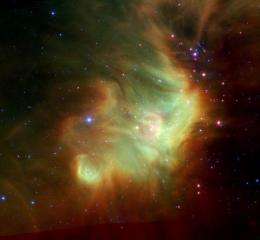Young stellar clusters

(PhysOrg.com) -- Most stars are thought to form in clusters rather than in isolation, as the gas and dust in a molecular cloud coalesces under the influence of gravity until clumps develop that are dense enough to become stars. Most massive stars are also found in such groupings, rather than in isolation.
There are some nearby star-forming regions, however, that for some reason deviate from this norm: their low mass stars are found in isolation, and they have no massive stars. It is not understood whether the differences arise because there are two distinct contexts for making stars, or because normal clustering occurs across a large continuum of cloud properties with a consequent range of group characteristics.
CfA astronomers Helen Kirk and Phil Myers analyzed the mass and spatial distributions of fourteen nearby, intermediate size young stellar groups looking for evidence of a sharp distinction between clustered and isolated modes of star formation. The groups were chosen because they are young (their stars have not moved very far away from their birthplaces), yet old enough that the mass of each young star can be accurately determined from its spectrum. In addition, the stars are spatially distinct, and the stellar population of each group has been well determined.
The astronomers conclude that, at least for the groups they examined, the properties are scaled-down versions of large cluster characteristics. The groups' masses span a wide range that is statistically consistent with the normal distribution seen, and moreover there is a correlation between the mass of the most massive star in each group and that of the whole group.
Finally, they find that the most massive member tends to be found near the center of the cluster, just as it does in more massive examples. The results, besides quantifying the cluster properties of these nearby regions, support the conclusion that there is only one mode of star formation at work in both regimes of isolated and clustered star formation.
Provided by Harvard-Smithsonian Center for Astrophysics


















